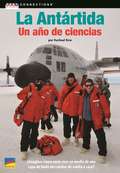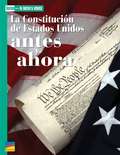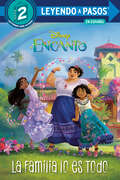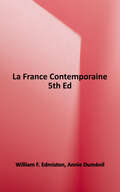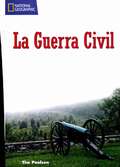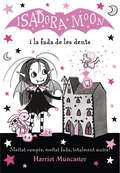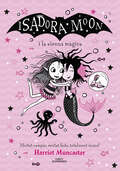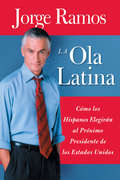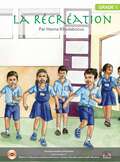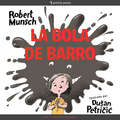- Table View
- List View
La Constitución de Estados Unidos antes y ahora: Textos Para La Lectura Atenta (Texts Close Reading )
by Benchmark Education Co. Llc StaffNIMAC-sourced textbook
La Estatua de la Libertad (¡Arriba la Lectura!, Level N #39)
by Mary PorscheSeguramente han visto imágenes de la Estatua de la Libertad, pero ¿sabes de dónde es esta famosa estatua o cuándo la construyeron? Descubre todo lo que hay que saber sobre la Dama de la Libertad en este libro. NIMAC-sourced textbook
La Extraordinariamente Ordinaria Vida de Cassandra Jones: Los Gatos Salvajes de Walker Año 1
by Tamara Hart HeinerLa vida como estudiante de quinto grado es cualquier cosa menos ordinaria. La extraordinariamente ordinaria vida de Cassandra Jones: gatos monteses caminante año 1: edad 10 Libro 1 de 8 hasta el momento en una serie en curso. ¿Qué tiene de especial Cassandra? Absolutamente nada. Ella es tan ordinaria como cualquier otro alumno de quinto grado. Y, sin embargo, su vida cotidiana está plagada de contratiempos divertidos, a veces desgarradores, mientras se guía por el mundo de los preadolescentes al borde de la edad adulta. Cassandra Jones es la chica nueva en la escuela. Fue desarraigada de su amado estado de Texas y se trasladó a la palurda Ozarks de Springdale, Arkansas. Ella se pregunta si le gustará su maestra o si tendrá amigos. Sólo puede esperar que la escuela no sea más difícil de lo que era en casa. Ella no espera tener dos amigas cercanas, y lo que es peor, dos amigas que no se quieren. Mientras trata de buscar su lugar, ¿Mantendrá sus amistades intactas?
La Familia lo es Todo (LEYENDO A PASOS (Step into Reading))
by Luz M. MackEdición en español de la serie LEYENDO A PASOS para lectores en el PASO 2. Libro basado en la película Encanto de Disney.Encanto cuenta la historia de los Madrigal, una familia extraordinaria que vive en una casa mágica escondida en las montañas de Colombia. La magia del Encanto ha bendecido a todos los integrantes de la familia con un fantástico don, desde la súper fuerza hasta el poder de sanar con la comida. A todos, excepto a Mirabel. Al descubrir que la magia que rodea al Encanto está en peligro, Mirabel, la única Madrigal sin un don, podría ser la última esperanza de su excepcional familia. Niños y niñas entre los 4 y 6 años de edad disfrutarán de este divertido cuento basado en la película Encanto de Disney. Este libro forma parte de LEYENDO A PASOS, una serie de textos adecuados para cada nivel de lectura. Los libros del PASO 2 usan vocabulario básico y oraciones cortas para narrar historias sencillas. Son adecuados para lectores que reconocen palabras familiares y que comprenden y vocalizan palabras nuevas con un poco de ayuda. This Step 2 LEYENDO A PASOS leveled reader is based on Disney&’s Encanto!Disney&’s Encanto tells the tale of an extraordinary family, the Madrigals, who live hidden in the mountains of Colombia, in a magical house, in a vibrant town, in a wondrous, charmed place called an Encanto. The magic of the Encanto has blessed every child in the family with a unique gift, ranging from superstrength to the power to heal—every child except one, Mirabel. But when she discovers that the magic surrounding the Encanto is in danger, Mirabel decides that she, the only ordinary Madrigal, might just be her exceptional family&’s last hope. Children ages 4 to 6 will love this Step 2 LEYENDO A PASOS leveled reader based on the animated feature film. Step 2 readers use basic vocabulary and short sentences to tell simple stories and are for children who recognize familiar words and can sound out new words with help. LEYENDO A PASOS is a Spanish-language line of Step into Reading.
La France Contemporaine
by William Edmiston Annie DumenilImmerse yourself in the France of today with this text, which will improve your understanding of the Francophone world and your communication in French, using up-to-date information on the political, social, technological, economic, and rich cultural forces that affect this fascinating country and its people. End-of-chapter comprehension and discussion activities, sample quizzes, and an integrated companion website help you master the material and fully appreciate everything that makes France French.
La Gran Barrera de Coral (¡Arriba la Lectura!, Level P #27)
by Debbie Croft Nathalie OrtegaNIMAC-sourced textbook. ¡La Gran Barrera de Coral de Australia es la estructura formada por seres vivos más larga del mundo! Es el hogar de muchos tipos de coral, peces y otras criaturas. Pero el futuro de la Gran Barrera de Coral está en peligro.
La Guerra Civil: Language, Literacy and Vocabulary—Reading Expeditions (EE UU. Historia y Vida) (Language, Literacy, and Vocabulary: Reading Expeditions En Español Series)
by National Geographic LearningLanguage, Literacy & Vocabulary - Reading Expeditions (EE.UU. Historia Y Vida): La Guerra Civil (Language, Literacy, and Vocabulary: Reading Expeditions en espanol)
La Isadora Moon i la fada de les dents (La Isadora Moon #Volumen 10)
by Harriet MuncasterMeitat fada, meitat vampir, i totalment única! Sembla que a la Isadora li ha de caure una dent... La Isadora Moon és especial perquè és diferent. La seva mare és una fada, el seu pare un vampir i ella té una miqueta de tots dos. La Isadora té un ullal que li belluga! Quan li caigui o bé el pot guardar, com fan els vampirs, o bé donar-lo a l'ajudant de la fada de les dents, la rateta Mignonette. Però i si abans fes un pícnic a mitjanit?
La Isadora Moon i la sirena màgica: Un llibre màgic amb purpurina a la coberta! (Grans històries de la Isadora Moon #Volumen 5)
by Harriet MuncasterMeitat fada, meitat vampir, i totalment única! El nou llibre de la Isadora Moon Isadora Moon és especial perquè és diferent. La seva mare és una fada, el seu pare és un vampir i ella té una miqueta de tots dos. A la Isadora li fa molta il·lusió anar a una festa de pijames amb les seves amigues sirenes. Allà coneix la Maragda, una sirena que no sembla gaire contenta de ser-hi. Què li passa, a la Maragda? De ben segur que una aventura submarina és la millor manera de fer amigues! Gaudeix de la lectura amb les encantadores i divertides aventures de la Isadora Moon, ideals per a lectors a partir de 7 anys que volen flors i purpurina, però als quals també agrada el món misteriós dels vampirs.
La Mariposa (Into Reading, Trade Book #1)
by Francisco Jiménez Simón SilvaNIMAC-sourced textbook. In his first year of school, Francisco understands little of what his teacher says. But he is drawn to the silent, slow-moving caterpillar in the jar next to his desk. He knows caterpillars turn into butterflies, but just how do they do it? To find out, he studies the words in a butterfly book so many times that he can close his eyes and see the black letters, but he still can't understand their meaning. Illustrated with paintings as deep and rich as the wings of a butterfly, this honest, unsentimental account of a schoolchild's struggle to learn language reveals that our imaginations powerfully sustain us. La Mariposa makes a subtle plea for tolerance in our homes, our communities, and in our schools.
La Mariposa (¡Arriba la Lectura!, Trade Book #1)
by Francisco Jiménez Simón SilvaNIMAC-sourced textbook
La Odisea: Mito Griego (Reader's Theater Folktales, Myths And Legends Ser.)
by Jeannette SandersonNIMAC-sourced textbook
La Ola Latina
by Jorge RamosEn La Ola Latina el reconocido escritor y galardonado periodista Jorge Ramos explora el impresionante crecimiento de los hispanos y analiza cómo los latinos estántransformando la economía, la cultura y la política de Estados Unidos. En los últimos años la población latina en Estados Unidos ha crecido de una manera extraordinaria, dándoles a los hispanos la posibilidad de influir de forma muy significativa en las elecciones y en la vida política del país. En las elecciones del 2004, por ejemplo, se espera que el voto latino sea un factor determinante en por lo menos diez estados que tienen más del 10 por ciento de población hispana, incluyendo a Nueva York, Texas, California, Florida e Illinois. Es imposible ignorar una influencia tan grande y un voto tan importante. Para muchos es difícil comprender que el cambio más dramático que está viviendo este país no tiene nada que ver con la guerra contra el terrorismo o con la economía; tiene que ver, simplemente, con la revolución demográfica impulsada por los latinos. Es la ola latina. En el 2002 los latinos se convirtieron, oficialmente, en el grupo minoritario más grande de Estados Unidos, superando los 38 millones de habitantes. La noticia sorprendió porque no se esperaba que esto ocurriera hasta, al menos, una década después. Este tipo de crecimiento presagia que los latinos tendrán un papel fundamental en el futuro de Estados Unidos y, particularmente, en la política. Todo tendrá que pasar por el filtro de los hispanos porque Estados Unidos se está latinizando. Si las tendencias no cambian, habrá más latinos que blancos no hispanos en el país el próximo siglo. Los latinos -- tanto los inmigrantes recién llegados como aquellos que nacieron en Estados Unidos -- están cambiando para siempre el tejido social y cultural de este país. En La Ola Latina , Ramos afirma que será aquel partido político que mejor comprenda los deseos y las necesidades de los hispanos que viven en este país, el que eventualmente ganará las próximas elecciones.
La Récréation class 1 - MIE
by Par Hanna Khodabocus"La Récréation" est un livre géant conçu pour stimuler l'éveil à la littératie chez les élèves de première année. L'histoire se déroule pendant la récréation à l'école, où Sara et le narrateur jouent à cache-cache avec leurs amis, tandis que d'autres enfants participent à des courses, jouent au ballon, à la marelle ou simplement discutent. L'atmosphère dynamique et diversifiée de la récréation est illustrée à travers différentes activités des enfants. Cependant, l'ambiance ludique est brièvement interrompue lorsque Robin se blesse, soulignant l'importance de la prudence pendant le jeu. La cloche sonne, annonçant la fin de la récréation et le retour en classe. Ce livre vise à susciter l'interaction des élèves en les incitant à partager leurs expériences pendant la récréation, tout en développant leur compréhension du vocabulaire et en encourageant des activités créatives basées sur le thème de la récréation.
La Serpiente Arcoíris: Cuento aborigen australiano (¡Arriba la Lectura!, Level R #4)
by Chris Sarandis Bronwyn BancroftNIMAC-sourced textbook
La Sra. Higgs comienza la escuela (¡Arriba la Lectura!, Level J #27)
by Carmel Reilly Beth NorlingLa Sra. Higgs es la maestra nueva, ¡y hoy es su primer día en la escuela! Ella quiere que todo le salga bien, pero, ¿y si algo sale mal? NIMAC-sourced textbook
La actuación sorpresa de Zac (¡Arriba la Lectura!, Level L #59)
by Cameron Macintosh Tom JellettNIMAC-sourced textbook. Todos en la familia de Zac son artistas de circo, ¡menos Zac! La familia está ocupada ensayando su presentación del sábado por la noche. Pero el día antes de la gran función, algo sale mal. ¿Podrán Zack y su loro, Plumón, salvar la situación?
La alfombra del príncipe (¡Arriba la Lectura!, Level L #1)
by Katya Krenina Jacqueline GreeneUnos ladrones capturan al príncipe Jabib cuando sale a montar a caballo. El príncipe astuto ofrece fabricar alfombras para que los ladrones las vendan. ¿Logrará escapar de la cueva con su habilidad para tejer alfombras? NIMAC-sourced textbook
La asombrosa vida de las mariposas monarca (¡Arriba la Lectura!, Big Book Module #7)
by Ángela CalderónNIMAC-sourced textbook
La aventura de Luca en Florencia (¡Arriba la Lectura!, Level T #42)
by Cameron Macintosh Alessandro BaldanziEl hermano mayor de Luca, Renzo, se ha ido de la granja y se ha mudado a Florencia para trabajar como ayudante de un artista. Mientras Luca aprende carpintería con su padre, se pregunta cómo será vivir en el taller de una artista en la gran ciudad. NIMAC-sourced textbook
La bella durmiente: Un cuento moderno (¡Arriba la Lectura!, Level L #12)
by Jill McDougall Dori BerkovicSe organiza una fiesta por el nacimiento de la princesa Carla. Las hadas Maga y Brisa y su amigo, el duende Colibrí, van a concederle tres deseos a la niña. Pero nadie ha invitado al Hada Malvada y eso la tiene de muy mal humor. NIMAC-sourced textbook
La bola de barro
by Robert Munsch Dusan PetricicCada vez que Jule Ann sale al jardín, una bola de barro le cae encima y la llena de barro. Ni bien se limpia completamente, la bola de barro la ataca de nuevo. Pero finalmente Jule Ann logra vencerla con su alegre ingenio y dos barras de apestoso jabón amarillo.
La burbuja feroz (¡Arriba la Lectura!, Trade Book #12)
by Adam Rubin Daniel SalmieriNIMAC-sourced textbook
La cabalgata nocturna de Sybil Ludington (¡Arriba la Lectura!, Level P #70)
by James Watling Marlene Pérez Joe LemonnierMuchos valientes trabajaron para liberarnos de los británicos. Entre ellos había una niña llamada Sybil. Lee sobre su cabalgata nocturna. NIMAC-sourced textbook
